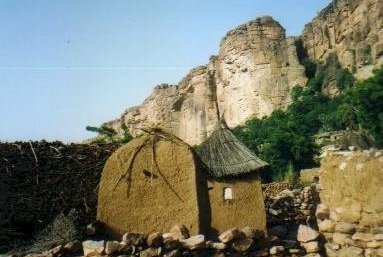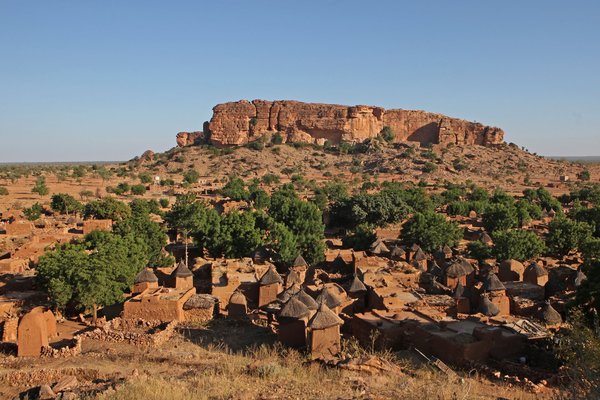Mali
Cliff of Bandiagara
The Cliff of Bandiagara (Land of the Dogons) is an eroded landscape of tablelands, gorges and plains that is inhabited by the traditionally living Dogon people.
The Dogon have withdrawn themselves to caves and rock shelters in this rocky area. They built their villages with distinct clay architecture. Sacred rituals from their traditional religion are closely connected to the landscape. The beautiful natural environment also provides the Dogon with medicinal plants.
Community Perspective: "undoubtedly one of the great sites of Africa". It is best seen as part of a multi-day trek, to enjoy village life, the Dogon way of greeting, the traditional woodwork of the doors, and the mask dances. Solivagant wonders about how inevitable change will affect this way of life, but we haven’t received another review for almost 20 years.
Site Info
Official Information
- Full Name
- Cliff of Bandiagara (Land of the Dogons) (ID: 516)
- Country
- Mali
- Status
-
Inscribed 1989
Site history
History of Cliff of Bandiagara
- 1989: Inscribed
- Inscribed
- 1981: Deferred
- At Bureau - needs clearer info
- 1980: Deferred
- Type
- Mixed
- Criteria
- v
- ix
Links
- UNESCO
- whc.unesco.org
- Related
-
- sacredsites.com — Link
All Links
UNESCO.org
- whc.unesco.org — whc.unesco.org/
Related Resources
- sacredsites.com — Link
News Article
- June 11, 2019 bbc.com — '100 killed' in ethnic Dogon village
- Oct. 15, 2011 dw-world.de — More than 270 Dogon sculptures, masks and everyday objects exhibited at the Bundeskunsthalle until January 22, 2012
Community Information
- Community Category
- Natural landscape: Mountain
- Urban landscape: African
Travel Information
Red Zone Travel Advisory
Recent Connections
-
Red Zone Travel Advisory
Mali fully off-limits -
Niger Basin
“the local drainage and seasonal stream… -
Mixed and Serial
Connections of Cliff of Bandiagara
- Geography
-
-
Sahel
-
Niger Basin
“the local drainage and seasonal streams in the area contribute to the Niger River system. Specifically, the Yamé River in Dogon Country is a tributary of the Niger River. “
-
- Trivia
-
-
Slow Food Movement
Somé (dried condiments) -
Minority communities
Dogon
-
- Ecology
-
-
Crocodiles
"Semi-domestic crocodiles are kept as sacred village protectors of Bandiagara and its ancient founder,Nangabanou Tembily. They are also revered so as to ensure continued rains in the ritual rain dances (Yaro and Diko, 1940)." (AB)
-
- Architecture
-
-
Cave Temples or Churches
Dwellings include altars, sanctuaries -
Earth Architecture
-
Cave dwellings
Inhabited by the Tellem and the Dogon, until now -
Vernacular architecture
-
- World Heritage Process
-
-
Inscribed at third attempt or more
Def 1980, Def 1981, Ins 1989 -
Mixed and Serial
-
- Religion and Belief
-
-
Living indigenous religions
Exceptional combinations of natural and cultural elements. The complex ritual relationships of the Dogon people with the environment include the use of curative and medicianl wild plants and the scared associations with pale fox, jackal and crocodile" (Crit niii)
-
- Human Activity
-
-
Masks
The Dogon have complex religious rituals that involve animal masks. -
Language isolate
Bangime (formerly considered a Dogon language, now established as an isolate)
-
- Constructions
-
-
Cultural sites connected to Cliffs
-
Granaries
the region is rich in unique architecture, ranging from flat-roofed huts to unusual tapering, granaries each capped with thatch, .. (AB ev)
-
- WHS on Other Lists
-
-
U.S. Ambassadors Fund
Preservation and Protection of Cultural Patrimony in Djenne and Bandiagara (2008) -
World Monuments Watch (past)
Bandiagara Escarpment Cultural Landscape (2004), Cultural Heritage Sites of Mali (2014)
-
- Timeline
-
-
Paleozoic
Rocks are predominantly upper sandstone of the Cambrian and Ordovician periodsSee www.eoearth.org
-
Built in the 15th century
Archaeological evidence suggests human occupancy of the cliffs for at leaat the last 1,000 years, although the Dogons themselves did not arrive until the 15th and 16th centuries." (AB) "Among the Dogon several oral traditions have been recorded as to their origin. One relates to their coming from Mande, located to the southwest of the Bandiagara escarpment near Bamako... It is likely that the Dogon of today combine several groups of diverse origin who migrated to escape Islamization. (wiki) Paul (as this is a "Cultural Landscape" what the Dogon did elsewhere is irrelevant. Although there are "Tellem" remains caves etc today's landscape is primarily "Dogon" and the OUV emphasises connection to that culture
-
- Visiting conditions
-
-
Red Zone Travel Advisory
Mali fully off-limits
-
News
- bbc.com 06/11/2019
- '100 killed' in ethnic Dogon villa…
- dw-world.de 10/15/2011
- More than 270 Dogon sculptures, ma…
Recent Visitors
Visitors of Cliff of Bandiagara
- Ali Zingstra
- Ask Gudmundsen
- Atila Ege
- Bill Maurmann
- CynthiaSam
- Don Irwin
- Els Slots
- Eric Lurio
- Erik Jelinek
- Eva Kisgyorgy
- Grzegorz Andruszkiewicz
- Harry Mitsidis
- Iain Jackson
- JoStof
- Kjlauer
- Kurt Lauer
- Luis Filipe Gaspar
- marcel staron
- Martin
- Mikko
- MMM
- Morodhi
- Nihal Ege
- Paul Schofield
- Reza
- Roman Bruehwiler
- Solivagant
- Stanislaw Warwas
- Szucs Tamas
- Thomas Buechler
- Westwards
Community Reviews
Show full reviews
The Dogon villages of the Bandiagara Falaise are undoubtedly one of the great sites of Africa. In Dec 2000 we did a 5 day trek among them and would love to return for a second visit. Even in December it is a very “hot walk” and I almost wonder whether a longer stay in 1 or 2 villages would be preferable to moving every day – the scenery doesn’t change that much and the essence of the place is to be found in the people and their culture. With French as a lingua franca and a local guide it was possible to interact. We learned the Dogon greeting with its extended list of polite questions and formal replies about a vast series of subjects. We saw the divination enclosures where the overnight footprints of desert foxes crossing prepared sand grids are used to foretell the future. We had discussions with locals who seemed prepared to forgive our unwitting social gaffes - eg I was politely asked not to lean on a particular rock – in Dogon animist beliefs “inanimate” objects possess significance which is not obvious to the outsider! We also had a masked dance performance (photo).
We asked ourselves whether our presence was for the better or were we killing what we had come to see. Well probably both. Looking back over almost 50 years of travel I can see that what appears to be permanent is in fact quite impermanent whether it be a natural site, city …
Keep reading 0 comments
Bandiagara is situated in central Mali (near Mopti) and is a good place for trekking from town to town. I did a 4-day trek, staying overnight in the villages of Bankas, Ende, Yabatalu and Begnimato. During the day we walked from village to village.
At night I slept on one of the roofs of the houses in the villages. This is very impressive, as you experience the daily life of the Dogon at close quarters. At 6 am the cocks start yelling, the donkeys begin to bray and the housewives get up to fetch water: an ideal alarm clock ...
It was a very memorable trip: admiring the fabulous ornamented woodwork of the doors, visiting the Hogon (traditional priest) and a mask dance was staged for us in the early morning hours.
Keep reading 0 comments
